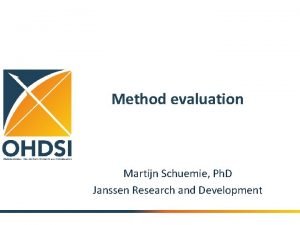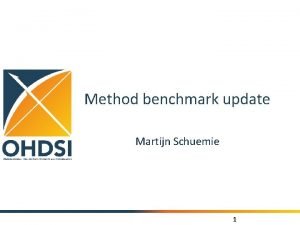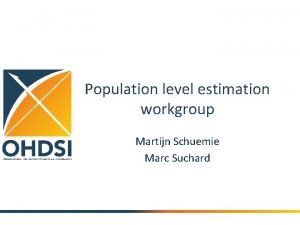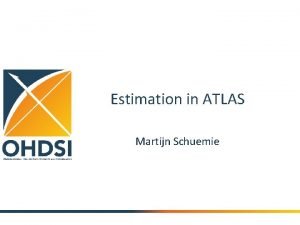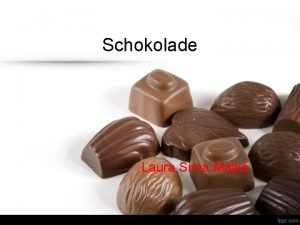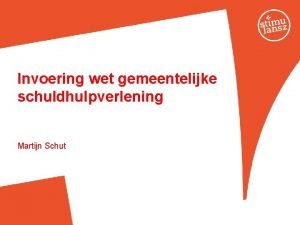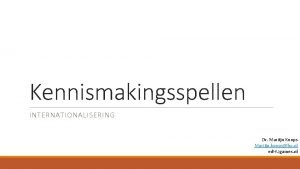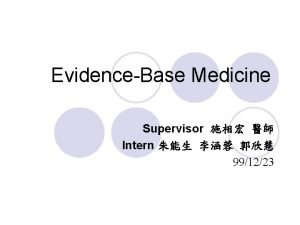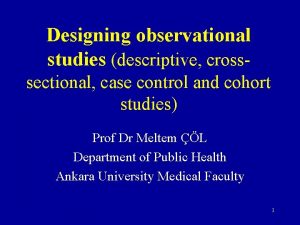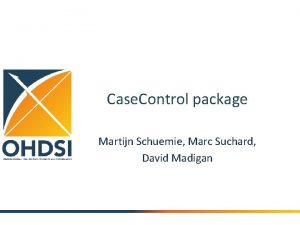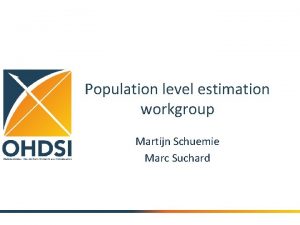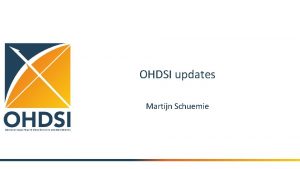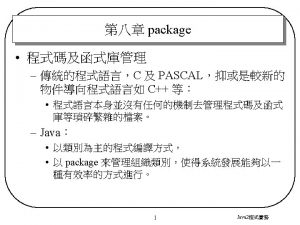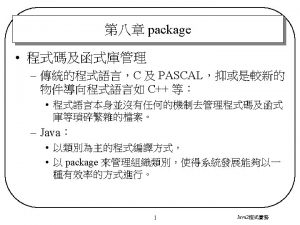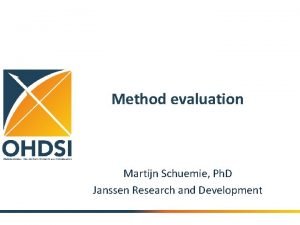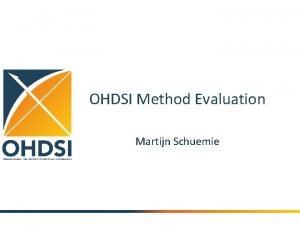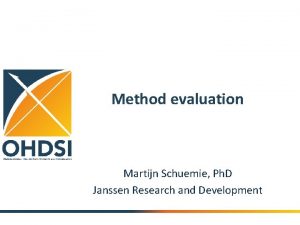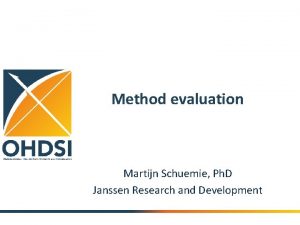Cohort Method package Martijn Schuemie Marc Suchard Patrick


































- Slides: 34

Cohort. Method package Martijn Schuemie, Marc Suchard, Patrick Ryan

Quick recap of previous meeting • Western hemisphere meeting cancelled due to lack of interest • We discussed the OHDSI Methods Library – – New-user cohort method using propensity scores Self-Controlled Case Series Self-Controlled Cohort IC Temporal Pattern Discovery • Necessity of analysis code validation (OHDSI Best Practice™) – – Unit testing Simulation Code review Double coding • Interest in additional methods – Case-control? – Methods to deal with time-varying exposure

New-user cohort design Total population Initiation of treatment Treated cohort Comparator cohort

Randomized controlled trial Total population Initiation of treatment Treatment arm Randomization Control arm

New-user cohort design Total population Initiation of treatment Treatment assignment is not random! Treated cohort Doctors have reasons why they prescribe a drug to some patients and not to others Comparator cohort

New-user cohort design Total population Celecoxib is thought to be safer So doctors give them to people who are more at risk Treated cohort Celecoxib GI Bleeds? Comparator cohort HR = 1. 24 (1. 01 – 1. 39) Diclofenac

Propensity score (PS) The propensity score is the probability of receiving the treatment, conditional on a set of baseline characteristics Intercept Charlson Comorbidity Index Prior GERD Age

PS score distribution

Using the PS • Trimming if P(treatment) is around 50%, treatment assignment ‘must be random’ • Stratification or matching only compare subjects to subjects with a similar PS • (Adding to the outcome model) correct for the PS in the model used to predict the outcome • (Inverse probability weighting) weigh subjects by inverse of propensity score

Effect of matching Cox regression: • Raw: HR = 1. 24 (1. 01 – 1. 39) • Using matched population, conditioning on matched sets: HR = 0. 83(0. 69 – 1. 00)

Which variables go into the PS model? • Traditional: hard thinking by expert • High-Dimensional PS: rank many variables (e. g. all drugs, conditions) by correlation with exposure (and maybe outcome), pick top n (Highly unstable) • Our approach: put everything (demographics, all drug classes, all conditions, all disease classes, all procedures, all observations, all severity indexes) in a regularized regression

Regularized regression

Regularized regression • Advantages: – Stable, even with many (> 10, 000) variables in the model – La. Place prior causes most betas to shrink to 0: easy to interpret final model – Let the data decide what is predictive (and what is not) • Feasible even at large scale: – OHDSI Cyclops package can run with millions of persons, hundreds of thousands of covariates • Automatic selection of hyperparameter (prior variance) – Cyclops uses cross-validation to pick parameter with highest out-ofsample likelihood

Outcome modeling Intercept Treatment Covariate 1 Covariate 2 Excluding treatment from regularization to - Get unbiased (non-shrunken) estimate - Be able to compute confidence intervals

Cohort. Method package cmd <- get. Db. Cohort. Method. Data(connection. Details , cdm. Database. Schema = cdm. Schema, target. Id = 1118084, comparator. Id = 1124300, outcome. Id = 192671, washout. Period = 183, first. Exposure. Only = TRUE, remove. Duplicate. Subjects = TRUE, exclude. Drugs. From. Covariates = TRUE, covariate. Settings = create. Covariate. Settings()) study. Pop <- create. Study. Population(cohort. Method. Data = cmd, outcome. Id = 192671 , remove. Subjects. With. Prior. Outcome = TRUE, min. Days. At. Risk = 1, risk. Window. Start = 0, risk. Window. End = 30, add. Exposure. Days. To. End = TRUE) ps <- create. Ps(cmd, study. Pop) plot. Ps(ps) strat. Pop <- match. On. Ps(ps, caliper = 0. 25, caliper. Scale = "standardized", max. Ratio = 1) plot. Ps(strat. Pop, ps) balance <- compute. Covariate. Balance(strata, cmd) plot. Covariate. Balance. Scatter. Plot(balance) plot. Covariate. Balance. Of. Top. Variables(balance) outcome. Model <- fit. Outcome. Model(strat. Pop, cmd use. Covariates = TRUE, model. Type = "cox", stratified = TRUE) plot. Kaplan. Meier(strat. Pop, include. Zero = FALSE) draw. Attrition. Diagram(strat. Pop) outcome. Model 18

Cohort. Method package cmd <- get. Db. Cohort. Method. Data(connection. Details , cdm. Database. Schema = cdm. Schema, target. Id = 1118084, comparator. Id = 1124300, outcome. Id = 192671, washout. Period = 183, first. Exposure. Only = TRUE, remove. Duplicate. Subjects = TRUE, exclude. Drugs. From. Covariates = TRUE, covariate. Settings = create. Covariate. Settings()) study. Pop <- create. Study. Population(cohort. Method. Data = cmd, outcome. Id = 192671 , remove. Subjects. With. Prior. Outcome = TRUE, min. Days. At. Risk = 1, risk. Window. Start = 0, risk. Window. End = 30, add. Exposure. Days. To. End = TRUE) ps <- create. Ps(cmd, study. Pop) plot. Ps(ps) strat. Pop <- match. On. Ps(ps, caliper = 0. 25, caliper. Scale = "standardized", max. Ratio = 1) plot. Ps(strat. Pop, ps) balance <- compute. Covariate. Balance(strata, cmd) plot. Covariate. Balance. Scatter. Plot(balance) plot. Covariate. Balance. Of. Top. Variables(balance) outcome. Model <- fit. Outcome. Model(strat. Pop, cmd use. Covariates = TRUE, model. Type = "cox", stratified = TRUE) plot. Kaplan. Meier(strat. Pop, include. Zero = FALSE) draw. Attrition. Diagram(strat. Pop) outcome. Model Get all the data from the CDM database: - Target cohort - Comparator cohort - One or more outcomes - Covariates - Default: ‘Kitchen sink’ - Option to specify custom covariates 19

Cohort. Method package cmd <- get. Db. Cohort. Method. Data(connection. Details , cdm. Database. Schema = cdm. Schema, target. Id = 1118084, comparator. Id = 1124300, outcome. Id = 192671, washout. Period = 183, first. Exposure. Only = TRUE, remove. Duplicate. Subjects = TRUE, exclude. Drugs. From. Covariates = TRUE, covariate. Settings = create. Covariate. Settings()) study. Pop <- create. Study. Population(cohort. Method. Data = cmd, outcome. Id = 192671 , remove. Subjects. With. Prior. Outcome = TRUE, min. Days. At. Risk = 1, risk. Window. Start = 0, risk. Window. End = 30, add. Exposure. Days. To. End = TRUE) ps <- create. Ps(cmd, study. Pop) plot. Ps(ps) strat. Pop <- match. On. Ps(ps, caliper = 0. 25, caliper. Scale = "standardized", max. Ratio = 1) plot. Ps(strat. Pop, ps) balance <- compute. Covariate. Balance(strata, cmd) plot. Covariate. Balance. Scatter. Plot(balance) plot. Covariate. Balance. Of. Top. Variables(balance) outcome. Model <- fit. Outcome. Model(strat. Pop, cmd use. Covariates = TRUE, model. Type = "cox", stratified = TRUE) plot. Kaplan. Meier(strat. Pop, include. Zero = FALSE) draw. Attrition. Diagram(strat. Pop) outcome. Model Create a study population - Remove subjects with prior outcome - Specify risk window - … 20

Cohort. Method package cmd <- get. Db. Cohort. Method. Data(connection. Details , cdm. Database. Schema = cdm. Schema, target. Id = 1118084, comparator. Id = 1124300, outcome. Id = 192671, washout. Period = 183, first. Exposure. Only = TRUE, remove. Duplicate. Subjects = TRUE, exclude. Drugs. From. Covariates = TRUE, covariate. Settings = create. Covariate. Settings()) study. Pop <- create. Study. Population(cohort. Method. Data = cmd, outcome. Id = 192671 , remove. Subjects. With. Prior. Outcome = TRUE, min. Days. At. Risk = 1, risk. Window. Start = 0, risk. Window. End = 30, add. Exposure. Days. To. End = TRUE) ps <- create. Ps(cmd, study. Pop) plot. Ps(ps) strat. Pop <- match. On. Ps(ps, caliper = 0. 25, caliper. Scale = "standardized", max. Ratio = 1) plot. Ps(strat. Pop, ps) balance <- compute. Covariate. Balance(strata, cmd) plot. Covariate. Balance. Scatter. Plot(balance) plot. Covariate. Balance. Of. Top. Variables(balance) outcome. Model <- fit. Outcome. Model(strat. Pop, cmd use. Covariates = TRUE, model. Type = "cox", stratified = TRUE) plot. Kaplan. Meier(strat. Pop, include. Zero = FALSE) draw. Attrition. Diagram(strat. Pop) outcome. Model Create propensity scores - By default using regularized regression 21

Cohort. Method package cmd <- get. Db. Cohort. Method. Data(connection. Details , cdm. Database. Schema = cdm. Schema, target. Id = 1118084, comparator. Id = 1124300, outcome. Id = 192671, washout. Period = 183, first. Exposure. Only = TRUE, remove. Duplicate. Subjects = TRUE, exclude. Drugs. From. Covariates = TRUE, covariate. Settings = create. Covariate. Settings()) study. Pop <- create. Study. Population(cohort. Method. Data = cmd, outcome. Id = 192671 , remove. Subjects. With. Prior. Outcome = TRUE, min. Days. At. Risk = 1, risk. Window. Start = 0, risk. Window. End = 30, add. Exposure. Days. To. End = TRUE) ps <- create. Ps(cmd, study. Pop) plot. Ps(ps) strat. Pop <- match. On. Ps(ps, caliper = 0. 25, caliper. Scale = "standardized", max. Ratio = 1) plot. Ps(strat. Pop, ps) balance <- compute. Covariate. Balance(strata, cmd) plot. Covariate. Balance. Scatter. Plot(balance) plot. Covariate. Balance. Of. Top. Variables(balance) outcome. Model <- fit. Outcome. Model(strat. Pop, cmd use. Covariates = TRUE, model. Type = "cox", stratified = TRUE) plot. Kaplan. Meier(strat. Pop, include. Zero = FALSE) draw. Attrition. Diagram(strat. Pop) outcome. Model Plot the propensity score distribution Diagnostic: too little overlap means stop! 22

Cohort. Method package cmd <- get. Db. Cohort. Method. Data(connection. Details , cdm. Database. Schema = cdm. Schema, target. Id = 1118084, comparator. Id = 1124300, outcome. Id = 192671, washout. Period = 183, first. Exposure. Only = TRUE, remove. Duplicate. Subjects = TRUE, exclude. Drugs. From. Covariates = TRUE, covariate. Settings = create. Covariate. Settings()) study. Pop <- create. Study. Population(cohort. Method. Data = cmd, outcome. Id = 192671 , remove. Subjects. With. Prior. Outcome = TRUE, min. Days. At. Risk = 1, risk. Window. Start = 0, risk. Window. End = 30, add. Exposure. Days. To. End = TRUE) ps <- create. Ps(cmd, study. Pop) plot. Ps(ps) strat. Pop <- match. On. Ps(ps, caliper = 0. 25, caliper. Scale = "standardized", max. Ratio = 1) plot. Ps(strat. Pop, ps) balance <- compute. Covariate. Balance(strata, cmd) plot. Covariate. Balance. Scatter. Plot(balance) plot. Covariate. Balance. Of. Top. Variables(balance) outcome. Model <- fit. Outcome. Model(strat. Pop, cmd use. Covariates = TRUE, model. Type = "cox", stratified = TRUE) plot. Kaplan. Meier(strat. Pop, include. Zero = FALSE) draw. Attrition. Diagram(strat. Pop) outcome. Model Match on propensity score - 1 -on-1 or variable ratio - Caliper 23

Cohort. Method package cmd <- get. Db. Cohort. Method. Data(connection. Details , cdm. Database. Schema = cdm. Schema, target. Id = 1118084, comparator. Id = 1124300, outcome. Id = 192671, washout. Period = 183, first. Exposure. Only = TRUE, remove. Duplicate. Subjects = TRUE, exclude. Drugs. From. Covariates = TRUE, covariate. Settings = create. Covariate. Settings()) study. Pop <- create. Study. Population(cohort. Method. Data = cmd, outcome. Id = 192671 , remove. Subjects. With. Prior. Outcome = TRUE, min. Days. At. Risk = 1, risk. Window. Start = 0, risk. Window. End = 30, add. Exposure. Days. To. End = TRUE) ps <- create. Ps(cmd, study. Pop) plot. Ps(ps) strat. Pop <- match. On. Ps(ps, caliper = 0. 25, caliper. Scale = "standardized", max. Ratio = 1) plot. Ps(strat. Pop, ps) balance <- compute. Covariate. Balance(strata, cmd) plot. Covariate. Balance. Scatter. Plot(balance) plot. Covariate. Balance. Of. Top. Variables(balance) outcome. Model <- fit. Outcome. Model(strat. Pop, cmd use. Covariates = TRUE, model. Type = "cox", stratified = TRUE) plot. Kaplan. Meier(strat. Pop, include. Zero = FALSE) draw. Attrition. Diagram(strat. Pop) outcome. Model Plot propensity score distribution after matching 24

Cohort. Method package cmd <- get. Db. Cohort. Method. Data(connection. Details , cdm. Database. Schema = cdm. Schema, target. Id = 1118084, comparator. Id = 1124300, outcome. Id = 192671, washout. Period = 183, first. Exposure. Only = TRUE, remove. Duplicate. Subjects = TRUE, exclude. Drugs. From. Covariates = TRUE, covariate. Settings = create. Covariate. Settings()) study. Pop <- create. Study. Population(cohort. Method. Data = cmd, outcome. Id = 192671 , remove. Subjects. With. Prior. Outcome = TRUE, min. Days. At. Risk = 1, risk. Window. Start = 0, risk. Window. End = 30, add. Exposure. Days. To. End = TRUE) ps <- create. Ps(cmd, study. Pop) plot. Ps(ps) strat. Pop <- match. On. Ps(ps, caliper = 0. 25, caliper. Scale = "standardized", max. Ratio = 1) plot. Ps(strat. Pop, ps) balance <- compute. Covariate. Balance(strata, cmd) plot. Covariate. Balance. Scatter. Plot(balance) plot. Covariate. Balance. Of. Top. Variables(balance) outcome. Model <- fit. Outcome. Model(strat. Pop, cmd use. Covariates = TRUE, model. Type = "cox", stratified = TRUE) plot. Kaplan. Meier(strat. Pop, include. Zero = FALSE) draw. Attrition. Diagram(strat. Pop) outcome. Model Compute covariate balance before and after matching Diagnostic: difference > 0. 1 after matching means stop 25

Cohort. Method package cmd <- get. Db. Cohort. Method. Data(connection. Details , cdm. Database. Schema = cdm. Schema, target. Id = 1118084, comparator. Id = 1124300, outcome. Id = 192671, washout. Period = 183, first. Exposure. Only = TRUE, remove. Duplicate. Subjects = TRUE, exclude. Drugs. From. Covariates = TRUE, covariate. Settings = create. Covariate. Settings()) study. Pop <- create. Study. Population(cohort. Method. Data = cmd, outcome. Id = 192671 , remove. Subjects. With. Prior. Outcome = TRUE, min. Days. At. Risk = 1, risk. Window. Start = 0, risk. Window. End = 30, add. Exposure. Days. To. End = TRUE) ps <- create. Ps(cmd, study. Pop) plot. Ps(ps) strat. Pop <- match. On. Ps(ps, caliper = 0. 25, caliper. Scale = "standardized", max. Ratio = 1) plot. Ps(strat. Pop, ps) balance <- compute. Covariate. Balance(strata, cmd) plot. Covariate. Balance. Scatter. Plot(balance) plot. Covariate. Balance. Of. Top. Variables(balance) outcome. Model <- fit. Outcome. Model(strat. Pop, cmd use. Covariates = TRUE, model. Type = "cox", stratified = TRUE) plot. Kaplan. Meier(strat. Pop, include. Zero = FALSE) draw. Attrition. Diagram(strat. Pop) outcome. Model Fit the outcome model - Cox, Poisson, or logistic - Conditioned on matched sets / strata? - Include all covariates? 26

Cohort. Method package cmd <- get. Db. Cohort. Method. Data(connection. Details , cdm. Database. Schema = cdm. Schema, target. Id = 1118084, comparator. Id = 1124300, outcome. Id = 192671, washout. Period = 183, first. Exposure. Only = TRUE, remove. Duplicate. Subjects = TRUE, exclude. Drugs. From. Covariates = TRUE, covariate. Settings = create. Covariate. Settings()) study. Pop <- create. Study. Population(cohort. Method. Data = cmd, outcome. Id = 192671 , remove. Subjects. With. Prior. Outcome = TRUE, min. Days. At. Risk = 1, risk. Window. Start = 0, risk. Window. End = 30, add. Exposure. Days. To. End = TRUE) ps <- create. Ps(cmd, study. Pop) plot. Ps(ps) strat. Pop <- match. On. Ps(ps, caliper = 0. 25, caliper. Scale = "standardized", max. Ratio = 1) plot. Ps(strat. Pop, ps) balance <- compute. Covariate. Balance(strata, cmd) plot. Covariate. Balance. Scatter. Plot(balance) plot. Covariate. Balance. Of. Top. Variables(balance) outcome. Model <- fit. Outcome. Model(strat. Pop, cmd use. Covariates = TRUE, model. Type = "cox", stratified = TRUE) plot. Kaplan. Meier(strat. Pop, include. Zero = FALSE) draw. Attrition. Diagram(strat. Pop) outcome. Model Plot Kaplan Meier plot Diagnostic: Evidence of non-proportionality means stop 27

Cohort. Method package cmd <- get. Db. Cohort. Method. Data(connection. Details , cdm. Database. Schema = cdm. Schema, target. Id = 1118084, comparator. Id = 1124300, outcome. Id = 192671, washout. Period = 183, first. Exposure. Only = TRUE, remove. Duplicate. Subjects = TRUE, exclude. Drugs. From. Covariates = TRUE, covariate. Settings = create. Covariate. Settings()) study. Pop <- create. Study. Population(cohort. Method. Data = cmd, outcome. Id = 192671 , remove. Subjects. With. Prior. Outcome = TRUE, min. Days. At. Risk = 1, risk. Window. Start = 0, risk. Window. End = 30, add. Exposure. Days. To. End = TRUE) ps <- create. Ps(cmd, study. Pop) plot. Ps(ps) strat. Pop <- match. On. Ps(ps, caliper = 0. 25, caliper. Scale = "standardized", max. Ratio = 1) plot. Ps(strat. Pop, ps) balance <- compute. Covariate. Balance(strata, cmd) plot. Covariate. Balance. Scatter. Plot(balance) plot. Covariate. Balance. Of. Top. Variables(balance) outcome. Model <- fit. Outcome. Model(strat. Pop, cmd use. Covariates = TRUE, model. Type = "cox", stratified = TRUE) plot. Kaplan. Meier(strat. Pop, include. Zero = FALSE) draw. Attrition. Diagram(strat. Pop) outcome. Model Draw attrition diagram: how did I get here? 28

Cohort. Method package cmd <- get. Db. Cohort. Method. Data(connection. Details , cdm. Database. Schema = cdm. Schema, target. Id = 1118084, comparator. Id = 1124300, outcome. Id = 192671, washout. Period = 183, first. Exposure. Only = TRUE, remove. Duplicate. Subjects = TRUE, exclude. Drugs. From. Covariates = TRUE, covariate. Settings = create. Covariate. Settings()) study. Pop <- create. Study. Population(cohort. Method. Data = cmd, outcome. Id = 192671 , remove. Subjects. With. Prior. Outcome = TRUE, min. Days. At. Risk = 1, risk. Window. Start = 0, risk. Window. End = 30, add. Exposure. Days. To. End = TRUE) ps <- create. Ps(cmd, study. Pop) plot. Ps(ps) strat. Pop <- match. On. Ps(ps, caliper = 0. 25, caliper. Scale = "standardized", max. Ratio = 1) plot. Ps(strat. Pop, ps) balance <- compute. Covariate. Balance(strata, cmd) plot. Covariate. Balance. Scatter. Plot(balance) plot. Covariate. Balance. Of. Top. Variables(balance) outcome. Model <- fit. Outcome. Model(strat. Pop, cmd use. Covariates = TRUE, model. Type = "cox", stratified = TRUE) plot. Kaplan. Meier(strat. Pop, include. Zero = FALSE) draw. Attrition. Diagram(strat. Pop) outcome. Model Get outcome model 29

Evaluating residual bias A negative control is a hypothesis (related to the main study hypothesis) where the null hypothesis (no effect) is believed to be true For an unbiased estimate, only 5% of negative controls should have p <. 05

Unadjusted analysis Candidiasis of mouth GI bleeding Diagnostic: Evidence of large bias means stop Celecoxib vs diclofenac Hazard ratio

Propensity score matching Candidiasis of mouth Celecoxib vs diclofenac Hazard ratio

Matching + full outcome model Celecoxib vs diclofenac Hazard ratio

Conclusions • Cohort. Method package features – Large scale regression propensity models – Large scale regression outcome models • Using negative controls, we see a reduction in residual bias when using PS matching + full outcome model • We have already used Cohort. Method in several real studies

Next steps • Yuxi Tian (UCLA) is comparing our PS to HDPS • Need to write article showing ‘including instrumental variables in PS model leads to bias’ is nonsense • Disease risk scores instead of PS? • Inverse probability weighting?

Topic of next meeting(s)? • Method evaluation • Identifying the important questions that can be answered using observational research • Replicating RCTs in observational data • TMU’s web-based case-control study app • ? 36

Next workgroup meeting May 18 • 3 pm Hong Kong / Taiwan • 4 pm South Korea • 4: 30 pm Adelaide • 9 am Central European time http: //www. ohdsi. org/web/wiki/doku. php? id=projects: workgroups: est-methods 37
 Martijn schuemie
Martijn schuemie Case cross over
Case cross over Martijn schuemie
Martijn schuemie Martijn schuemie
Martijn schuemie Martijn schuemie
Martijn schuemie Marc suchard
Marc suchard Ohdsi atlas demo
Ohdsi atlas demo Retrospective cohort study
Retrospective cohort study Philippe sucharda
Philippe sucharda Schokolade herstellung
Schokolade herstellung Martijn schut
Martijn schut Martijn nolen
Martijn nolen Martijn weesing
Martijn weesing Martijn van de voort
Martijn van de voort Martijn priem
Martijn priem Tim van iersel
Tim van iersel Martijn van breden
Martijn van breden Martijn corbee
Martijn corbee Dulvaft
Dulvaft Martijn tennekes
Martijn tennekes Martijn tennekes
Martijn tennekes Martijn maas
Martijn maas Kahoot
Kahoot Martijn van der heide
Martijn van der heide Martijn mallie
Martijn mallie Martijn tennekes
Martijn tennekes Martijn burger
Martijn burger Martijn schuurman
Martijn schuurman Cohort study example
Cohort study example Retrospective cohort study
Retrospective cohort study Magnus
Magnus What is case series
What is case series Cohort model psycholinguistics
Cohort model psycholinguistics Cotrizine
Cotrizine Retrospective cohort study vs case control
Retrospective cohort study vs case control
